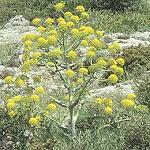
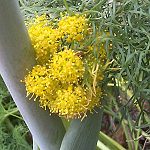

1,3(E),5(Z)-undecatriene (galbanolene) and
2-sec-butyl-3-methoxypyrazine (galbanum pyrazine)
Galbanum
Ferula galbaniflua, F. rubricaulis (Umbelliferae)
Galbanum is the air-dried gum-like exudate from two closely related species
of large umbellifers with yellow flowers, growing in Iran and Afghanistan.
The sap is collected from cuts in stems and branches. Since old ages galbanum
has been used as an ingredient for making incense, providing a distinctive
spicy note. By steam distillation of the gum, the so-called galbanum oil
is obtained, highly valued in perfumery for its natural, 'green' character.
Galbanum oil has been thoroughly investigated. A few compounds in low
concentration are responsible for the interesting odour characteristics,
e.g. 1,3(E),5(Z)-undecatriene (galbanolene), having a unique, transparent,
marine, somewhat green and metallic odour, and 2-sec-butyl-3-methoxypyrazine
(galbanum pyrazine), having a powerful pea-pod odour and a very low odour
detection threshold [6].
Parfumes of the Chypre and Fougère-type often use a galbanum-like
top-note, e.g. Vent Vert (Balmain 1945), Chanel No. 19 (Chanel 1970),
Sport Scent (Jovan 1978) and Elements Aqua (Boss 1997).
Several compounds have been developed with an odour resembling that of galbanolene but being easier to employ. One of them is allyl isoamyloxyacetate (allyl amyl glycolate), used in Drakkar Noir (Guy Laroche 1982), Cool Water (Davidoff 1988) and Egoïste Platinum (Chanel 1993) [43].
Another one is Dynascone ® (Firmenich), an extremely powerful and diffusive odorant with an odour reminiscent of galbanum, with a pineapple and hyacinth character.
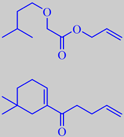
allyl isoamyloxyacetate and
Dynascone ®
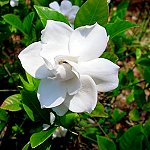

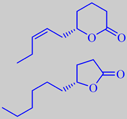


On the left: (S)-(+)-jasmine lactone and (R)-(+)-gamma-decalactone. Above: (E)-ocimene, (R)-(-)-linalool, and tiglic acid esters, R = methyl, ethyl, hexyl og 3(Z)-hexen-1-yl
Gardenia
Gardenia jasminoides (Rubiaceae)
The famous American jazz singer Billie Holiday (1915-59) had gardenia
as her beloved flower. She was inspired by its fragrance and often made
her appearances with gardenias in her hair.
The gardenia most commonly grown is a filled variety of G. jasminoides,
originating in southern China. The flowers need a high humidity to develop
properly.
(E)-ocimene together with linalool, methyl benzoate and a number of tiglic
acid esters are the major components of the gardenia flower headspace
[5]. A recent Japanese study determined the enatiomeric ratio of several
volatiles from gardenia flowers. Jasmine lactone, gamma-decalactone and
linalool was shown to be close to 100 % of the above chirality [4].
Etymology: Gardenia has its name from the American botanist Alexander
Garden. See also the Polynesian tiare.
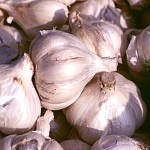

enzymatic generation of allicin from alliin and its further reaction into diallyl disulphide and vinyl-dithiines
Garlic
Allium sativum (Alliaceae)
Garlic is native to the plains of western Asia. Its use in cooking is
as old as humanity.
The undamaged garlic is without odour, but on cutting or pressing it,
strongly odoriferous and chemically reactive sulphur compounds are immediately
generated. This mechanism protects the garlic against parasites and moulds,
and is due to an enzymatic generation of allicin (diallyl disulphide sulphoxide)
from the stable compound alliin (S-allyl-L-cystein sulphoxide). The odour
of freshly cut garlic comes from allicin. Further reaction may result
in additional powerful odorant like diallyl disulphide and vinyl-[4H]-dithiines
[60]. The enzyme alliinase is denatured by short heating, and therefore
preserved garlic has a mild taste. Garlic's sulphur compounds are antibacterial
and antioxidative, and their medicinal benefits are still being investigated.
See also ramsons
and onion.
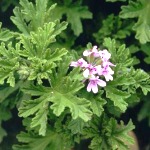
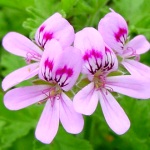
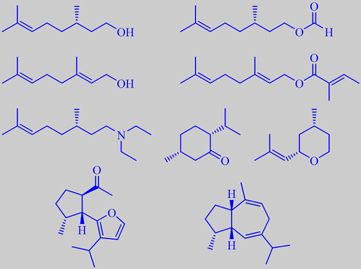
(-)-citronellol, citronellyl formate, geraniol, geranyl tiglate, citronellyl diethyl
amine, isomenthone, cis-rose oxide, furopelargone A, (-)-6,9-guaiadiene

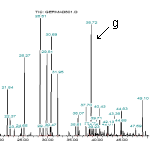
Pelargonium graveolens, P. roseum (Geraniaceae)
Pelargoniums are from South Africa. Geranium oil is obtained by steam distillation of the leaves of the flowering herbs of Pelargonium graveolens, P. roseum, and other hybrids that have developed into different ecotypes in different geographical regions. The leaves are covered with glandular hairs containing an essential oil somewhat resembling rose oil. Geranium oil is one of the most important essential oils in perfumery.
The main cultivation areas are Réunion and Madagascar (Bourbon type), Egypt (North African type), and China. The Bourbon oil is the most valuable. It has a very powerful, green, leafy-rosy odour with a pronounced fruity-minty undertone and a rich, long-lasting, sweet-rosy dryout. The amount of oil by steam distillation is as low as 0.15 %, but geraniums grow fast and the crop yield is substantial.
The oil contains about 80 % of equal parts of (-)-citronellol and geraniol along with smaller amounts of the corresponding formates and tiglates. Other components that are present in amounts > 1 % are, e.g., (-)-linalool,
cis-rose oxide (having an extremely diffusive, green-rosy, slightly metallic odour), (-)-isomenthone, furopelargone, and citronellyl diethyl amine (imparting a special floral odour with a slight quinoline-like undertone). The Bourbon type is characterized by high levels of (-)-6,9-guaiadiene [3][146].
Geranium oil has wide applications - from soap perfumes, a famous example being the highly scented Spanish Maja soap (Myrurgia 1918), to luxury perfumes, Youth-Dew (Estée Lauder 1953), for example.
Etymology: Gr. geranos, crane, and Gr. pelargos, stork, because of the shape of the seed capsules; Lat. graveolens, heavily odorous. La Réunion (Ile de Bourbon), a small island in the Indian Ocean 500 miles east of Madagascar.
P.S. The very diminished gas chromatogram in the lower right picture shows the analytical "finger print" of Bourbon type geranium oil. The peak marked with a "g" represents (-)-6,9-guaiadiene.
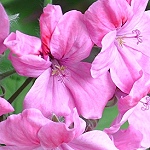
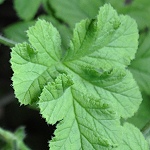

citronellic acid, beta-guaiene and (+)-aromadendrene
Multitudes of differently "scented geraniums" (pelargoniums) have been developed - and still are. Pelargoniums are easily propagated from cuttings, and transgenic modification has been performed in tissue cultures using e.g. Agrobacterium mediators. Scented geraniums are often displayed at gardening shows and enjoys much popularity. Odor classifications into rosy, minty, peppery, citrusy, camphoraceous, etc., are rather unprecise and new hybrids are presented all the time. Analytical work on the essential oils is modest. However, a scented geranium named Clorinda in my own possession (photo) might be mentioned here: On the slightest touch of its hairy stalks a powerful peppery odor is developed. Smelled on the skin this impression is succeeded by a more fruity dryout.
Lis-Balchin [333] mentions citronellic acid as a major compound of the peppery scented geraniums. Another study has b-guaiene and aromadendrene as major sesquiterpenes of P. 'Clorinda' [334].
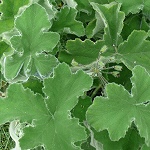
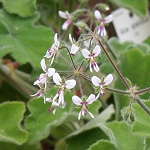

(+)-menthone and (-)-isomenthone
p.p.s.
Another interesting species of Pelargonium, being a potential source of
a peppermint-scented essential oil, is
P. tomentosum, a native of the southwestern Cape Province in
South Africa. Here it is confined to mountainous habitats where it thrives
in semi-shaded, moist places and is usually found on the margins of ravine
forest in sandy soil near streams. Its densely hairy leaves give off a
strong and bright peppermint odor when touched. The main components of
the steam distilled essential oil are (+)-menthone (25-27 %) and (-)-isomenthone
(61-62 %) [346].